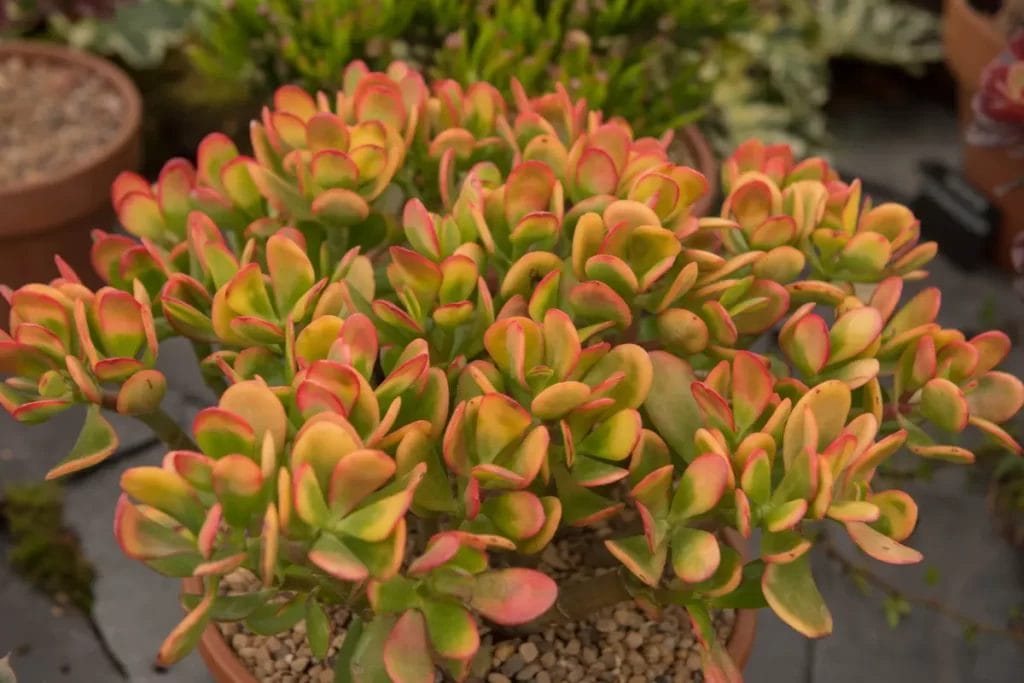How To Trick Your Jade Plant Leaves To Turn Red
Did you know that with a few simple tweaks to your jade plant‘s environment, you can encourage the leaves to develop a striking red hue?
By adjusting the amount of direct sunlight your plant receives each day, you can enhance the red pigmentation. It’s a delicate balance, though, as too much exposure can harm the plant. I’ve found that experimenting with different lighting conditions not only brings out this vibrant color but also invigorates the plant’s overall health.
Curious about how to strike the perfect balance without risking your jade’s wellbeing? I’ll guide you through the process.
Understanding Leaf Coloration
Anthocyanin, the pigment responsible for the red, purple, or blackish hues in plants, forms in jade plant leaves primarily due to direct sunlight exposure.
While some species naturally exhibit red-tinted edges, the intensity of this red pigmentation is deeply influenced by environmental factors beyond mere sunlight. For instance, stress conditions such as underwatering, cold temperatures, or nutrient deficiencies also play critical roles.
Understanding that the genetic makeup of the plant determines its baseline capacity for color variation is crucial. Therefore, while external conditions trigger pigmentation changes, the plant’s inherent genetic profile sets the boundaries for how dramatic these changes can be.
This interplay between genetics and environment crafts the unique color palette of each jade plant.
Light Exposure Effects

Direct sunlight greatly enhances the red pigmentation in jade plant leaves, intensifying their color. When I expose my jade plants to full, direct sunlight for several hours each day, I observe a marked increase in the red hues of their leaves.
This color change is due to the activation of anthocyanins, which are pigments that respond to light exposure. It’s essential to monitor the sunlight exposure closely, though, as the intensity and duration can significantly affect the stress level of the plant. By managing this exposure adeptly, the red coloration can be maximized without harming the plant.
Keep in mind that balance is key; too little light and the leaves will revert to green, too much, and they might incur sunburn.
Jade Plant Care Tips
To guarantee your jade plant thrives, place it in bright, indirect sunlight and water it sparingly. I’ve found that maintaining a consistent watering schedule is imperative—let the soil dry out completely between waterings to avoid root rot. Utilizing a well-draining soil mix further safeguards the health of your plant by preventing excess moisture retention. I recommend using a succulent or cactus soil mix, which provides the ideal balance for drainage and nutrient retention.
Feeding your jade plant should be done judiciously; a balanced, water-soluble fertilizer every three to four months during the growing season supports robust growth without overwhelming the plant. Always remember, less is often more when nurturing jade plants.
Managing Color Changes
While adequate care guarantees the health of your jade plant, adjusting its exposure to sunlight can also manage and even reverse changes in leaf coloration. I’ve honed my technique to maximize the red hues in my jade plants by controlling their light exposure meticulously. Here’s a table that details the light conditions and expected color outcomes based on my experiences:
| Light Exposure | Leaf Color Results |
|---|---|
| High direct sunlight | Intense red edges |
| Moderate sunlight | Mild red to pink hues |
| Low light | Green with slight red |
| Morning sunlight only | Soft red tints |
| Filtered light | Mostly green |
This approach lets you experiment and achieve just the right coloration for your jade. Adjusting sunlight exposure is key to manipulating these stunning color changes.
Propagation and Issues
Understanding the different propagation methods and common issues can greatly enhance the health and aesthetics of your jade plants. I’ve found that stem cuttings, leaf cuttings, offsets, and division are effective during the growing season. However, you must guarantee proper soil moisture and avoid direct sunlight initially to prevent stress.
Beware of pests like mealybugs and spider mites; they’re notorious for weakening jade plants. I recommend inspecting regularly and using a mild soap solution for early infestations. Additionally, poor drainage often leads to waterlogged conditions, causing root rot. I use well-draining soil and monitor watering closely.
Lastly, watch for nutrient imbalances—discolored or spotted leaves often indicate a need for adjusting your fertilization routine.
Conclusion
As I’ve navigated the dance of sunlight and shade with my jade plant, each leaf’s blush has become a proof to patience and attention. Crafting the perfect red in those plump leaves feels like painting sunsets with nature’s palette.
Remember, the secret lies in the gentle balance—too much sun scorches, too little dims. Like nurturing any masterpiece, guiding your jade’s transformation requires a tender hand and a watchful eye.
May your efforts bloom into a vivid display of fiery foliage.







